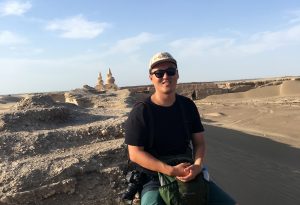As a specialist in the art and architecture of East and Central Asia from medieval and early modern periods, Yong Cho focuses on the question of how artistic creativity emerges when people, objects, and ideas move or become displaced from their place of origin. His research interests cover a broad range of topics: theories of cross-cultural contact, multiculturalism and multilingualism in visual arts, the visual and material cultures of mobile societies, sacred objects and their relationship to ritual, the relationship between making and meaning, and the historiography of Silk Road art and archaeology.
He is currently completing his first book The Woven Image: The Making of Mongol Art in the Yuan Empire (under contract with Yale University Press), which investigates a moment of major cultural transformation across Eurasia, when the Mongols, the tent-dwelling pastoral nomadic peoples of the North Asian steppe, became rulers of a world empire. By focusing on woven images, it traces how the Mongol visual culture had a lasting impact in the history of art in East Asia. This book project received research support from the Getty Research Institute, where he was in residence as a postdoctoral scholar during the 2021–22 academic year, and subvention support from the College Art Association Millard Meiss Publication Fund, the Chiang Ching-kuo Foundation Publication Subsidy, the Geiss Hsu Foundation Subvention Award, and International Center of Medieval Art-Kress Publication Grant.
Building upon his interests in the trans-Eurasian visual culture of the Mongol Empire, he has begun work on a new project, which investigates how the Mongol presence on the Korean peninsula during the last century of the Koryŏ (918–1392) led to the rise of new visual and material forms in Northeast Asia and beyond.
Education
Areas of Specialization and Research/Teaching Interests:
Interconnectedness of art and architecture in Eurasia from the 4th-14th centuries; Mongol Empire; theories and histories of cross-cultural contact; Buddhist art and architecture; nomadic art and architecture; textile history; material culture theories; animal studies; visual and material culture of shaman rituals in Korea, North Asia, and Siberia; cultural history of Korean diaspora in the former Soviet Union, Japan, China, and the Americas
“What Can the Patterns of Renovation Reveal? Afterlife of the Tibetan Empire in the Tangut Intervention at Dunhuang.” Journal of Asian Studies 84, no. 1 (2025): 139-167.
“The Grid and the Buddha Body: Measurement, Cloth, and Embodiment.” Artibus Asiae 84, no.1 (2024): 5-40.
“La taxonomie des arts à la cour des Yuan.” Translation by Divina Cabo. In Les Mongols et le monde: L’autre visage de l’empire de Gengis Khan, ed. Marie Favereau (Nantes: Musée d’histoire de Nantes, 2023), 218-19.
“Vajrabhairava Mandala.” In Himalayan Art in 108 Objects, eds. Karl Debreczeny and Elena Pakhoutova (New York: Rubin Museum of Art, 2023), 208-11.
https://projecthimalayanart.rubinmuseum.org/essays/vajrabhairava-mandala/
“Juyong Gate: Wall Hangings in Stone.” Archives of Asian Art 73, no.2 (2022): 221-53.
“Silk Road.” In The Encyclopedia of Ancient History: Asia and Africa, eds. D. Potts, E. Harkness, J. Neelis, and R. McIntosh (Malden, MA: Wiley-Blackwell, 2021).
https://doi.org/10.1002/9781119399919.eahaa00706.

